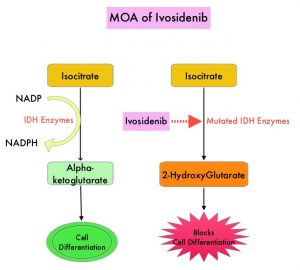SUMMARY: The American Cancer Society estimates that for 2021, about 60,430 people will be diagnosed with pancreatic cancer and about 48,220 people will die of the disease. Pancreatic cancer is the fourth most common cause of cancer-related deaths in the United States and Western Europe. Unfortunately, unlike other malignancies, very little progress has been made and outcome for patients with advanced pancreatic cancer has been dismal, with a 5-year survival rate for metastatic pancreatic cancer of approximately 2%. Pancreatic cancer has surpassed breast cancer as the third leading cause of cancer death in the United States and is on track to surpass colorectal cancer, to move to the second leading cause of cancer related deaths in the United States around 2021.
DNA damage is a common occurrence in daily life by UV light, ionizing radiation, replication errors, chemical agents, etc. This can result in single and double strand breaks in the DNA structure which must be repaired for cell survival. The two vital pathways for DNA repair in a normal cell are BRCA1/BRCA2 and PARP. BRCA1 and BRCA2 genes recognize and repair double strand DNA breaks via Homologous Recombination Repair (HRR) pathway. Homologous Recombination is a type of genetic recombination, and is a DNA repair pathway utilized by cells to accurately repair DNA double-stranded breaks during the S and G2 phases of the cell cycle, and thereby maintain genomic integrity. Homologous Recombination Deficiency (HRD) is noted following mutation of genes involved in HR repair pathway. At least 15 genes are involved in the Homologous Recombination Repair (HRR) pathway including BRCA1, BRCA2, PALB2, CHEK2 and ATM genes. BRCA1 and BRCA2 are tumor suppressor genes located on chromosome 17 and chromosome 13 respectively and functional BRCA proteins repair damaged DNA, and play an important role in maintaining cellular genetic integrity. They regulate cell growth and prevent abnormal cell division and development of malignancy. Mutations in these genes predispose an individual to develop malignant tumors. It is well established that the presence of BRCA1 and BRCA2 mutations can significantly increase the lifetime risk for developing breast and ovarian cancer, as high as 85% and 40% respectively. BRCA1/2 mutations have been detected in 4-7% of patients with pancreatic cancer, with a 2-6 fold increase in risk, associated with these mutations. These patients tend to be younger. Among pancreatic cancer patients with Ashkenazi Jewish ancestry, the prevalence of BRCA1/2 mutations is 6-19%, with mutations more common for BRCA2. NCCN guideline recommends that germline testing should be considered for all patients with pancreatic cancer and is especially recommended for those with a personal history of cancer, family history or clinical suspicion of a family history of pancreatic cancer. Approximately 10% of pancreatic cancer cases have a familial component. When hereditary cancer syndrome is suspected in patients with pancreatic cancer, genetic counseling should be considered.
BRCA mutations can either be inherited (Germline) and present in all individual cells or can be acquired and occur exclusively in the tumor cells (Somatic). Somatic mutations account for a significant portion of overall BRCA1 and BRCA2 aberrations. Loss of BRCA function due to frequent somatic aberrations likely deregulates HR pathway, and other pathways then come in to play, which are less precise and error prone, resulting in the accumulation of additional mutations and chromosomal instability in the cell, with subsequent malignant transformation. Homologous Recombination Deficiency therefore indicates an important loss of DNA repair function.
The PARP (Poly ADP Ribose Polymerase), family of enzymes include, PARP1 and PARP2, and is a related enzymatic pathway that repairs single strand breaks in DNA. In a BRCA mutant, the cancer cell relies solely on PARP pathway for DNA repair to survive. PARP inhibitors trap PARP onto DNA at sites of single-strand breaks, preventing their repair and generating double-strand breaks that cannot be repaired accurately in tumors harboring defects in Homologous Recombination Repair pathway genes, such as BRCA1 or BRCA2 mutations, and this leads to cumulative DNA damage and tumor cell death.
LYNPARZA® (Olaparib) is a PARP inhibitor and is presently approved as maintenance therapy for patients with advanced pancreatic cancer demonstrating a germline BRCA1 or BRCA2 pathogenic variant. However, previously published studies have demonstrated the benefit of PARP inhibitors in breast, prostate and ovarian cancer patients, beyond germline BRCA pathogenic variants. Further, there is an unmet need to expand the group of patients with pancreatic cancer who may benefit from therapy with a PARP inhibitor, beyond those with germline BRCA pathogenic variants.
This investigator-initiated, single-arm Phase II study was conducted to assess the role of oral, small molecule PARP inhibitor RUBRACA® (Rucaparib), as maintenance therapy in advanced pancreatic cancer with germline or somatic pathogenic variants in BRCA1, BRCA2, or PALB2 genes. This study enrolled 46 patients with advanced pancreatic cancer with germline or somatic pathogenic variants in BRCA1, BRCA2, or PALB2, and had received at least 16 weeks of platinum-based chemotherapy without evidence of platinum resistance, which was defined as growing tumors, new lesions, or a steadily rising tumor marker during or within 8 weeks of platinum therapy. The median age was 62 years, approximately 17% had germline BRCA1, 64% had germline BRCA2, 14% had germline PALB2 and 5% had somatic BRCA2 pathogenic variants. Majority of patients (95%) had metastatic disease and 5% had locally advanced disease. Ashkenazi Jewish founder mutation was found in 24% of patients. The Primary end point was Progression Free Survival (PFS) at 6 months (PFS). Secondary end points included Safety, Objective Response Rate (ORR), Disease Control Rate, Duration of Response, and Overall Survival.
The PFS at 6 months was 59.5% and the PFS at 12 months was 54.8%. The median PFS was 13.1 months and median Overall Survival was 23.5 months. The ORR in those with measurable disease was 42%, and the Disease Control Rate was 67%. The median Duration of Response was 17.3 months. These responses were noted across all germline and somatic pathogenic variants in BRCA1, BRCA2, and PALB2 genes, and no new safety signals were noted.
It was concluded from this study that maintenance RUBRACA® is a safe and effective therapy for platinum-sensitive, advanced pancreatic cancer patients, with a pathogenic variant in BRCA1, BRCA2, or PALB2. The authors added that the finding of efficacy in patients with germline PALB2 and somatic BRCA2 pathogenic variants, expands the population of patients likely to benefit from PARP inhibitors, beyond those with germline BRCA1 and BRCA2 pathogenic variants.
Phase II Study of Maintenance Rucaparib in Patients With Platinum-Sensitive Advanced Pancreatic Cancer and a Pathogenic Germline or Somatic Variant in BRCA1, BRCA2, or PALB2. Reiss KA, Mick R, O’Hara MH, et al. J Clin Oncol. 2021;39:2497-2505.


